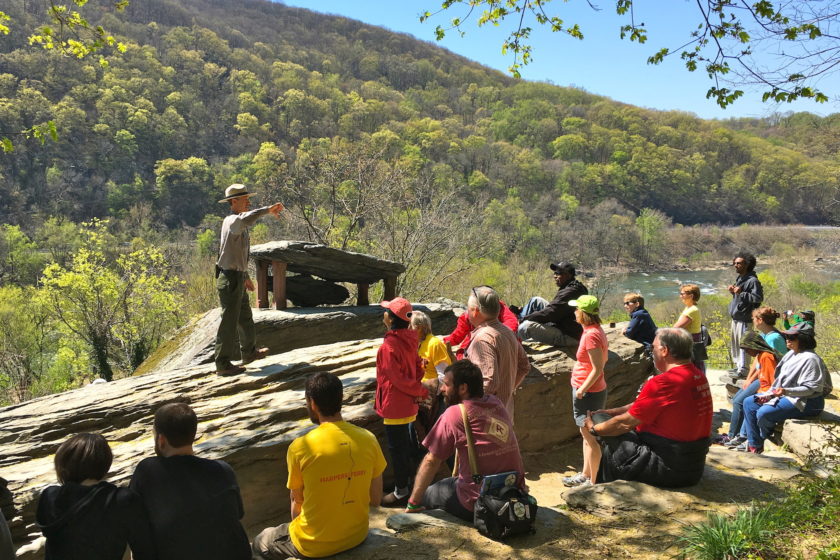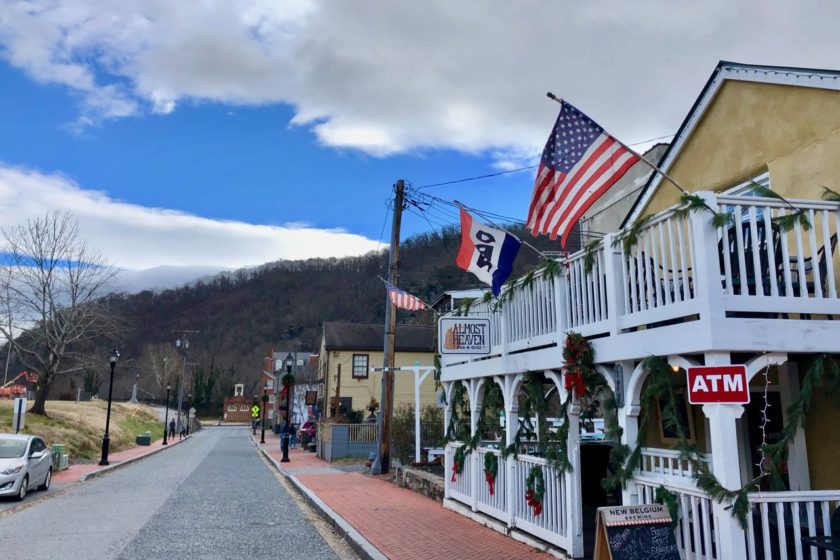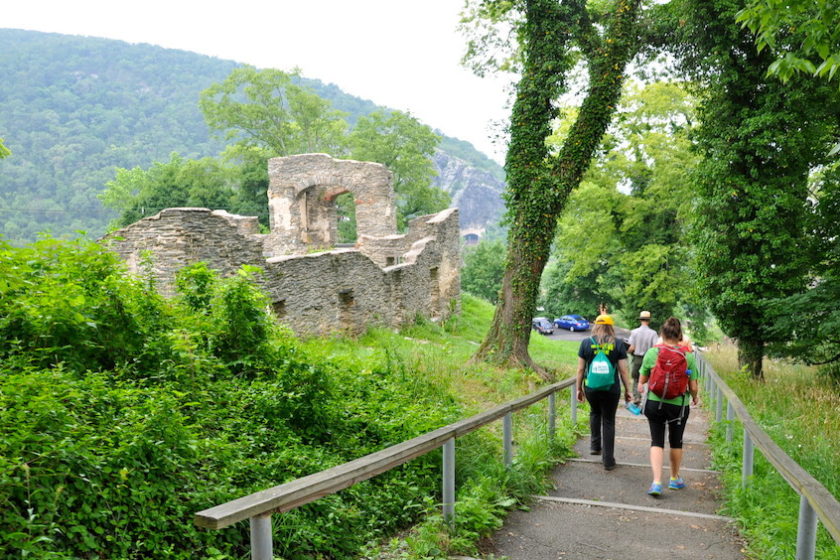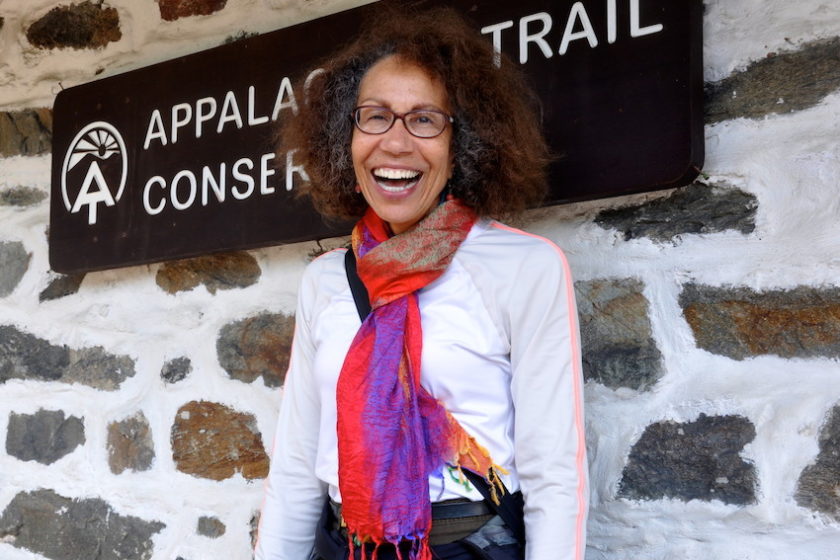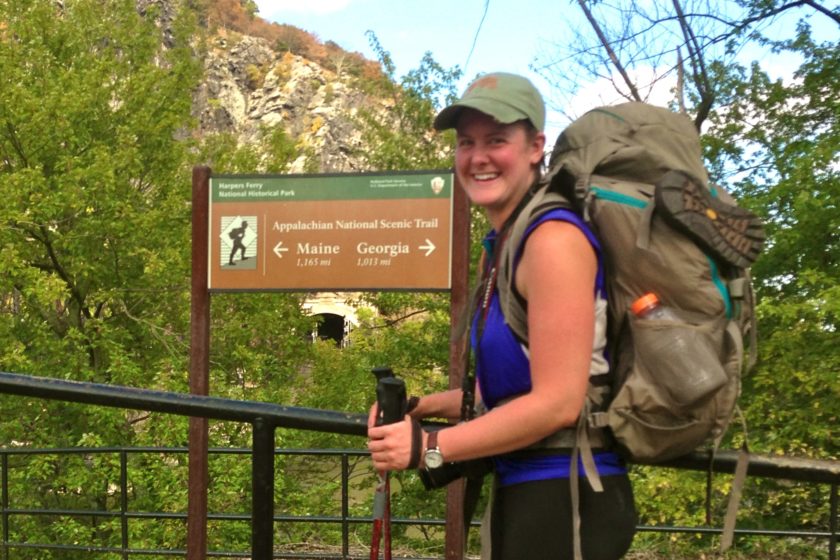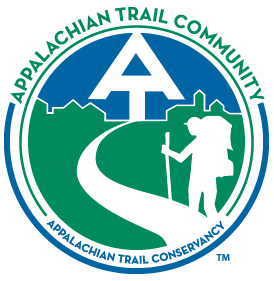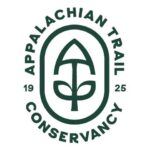Follow the Appalachian Trail through one of the most important historic towns in America
Harpers Ferry & Bolivar, W.Va.
Harpers Ferry offers a fantastic introduction to the Appalachian Trail in one of the most scenic and historic towns anywhere in America. Situated at the confluence of the Potomac and Shenandoah Rivers, the town and Harpers Ferry National Historical Park are most famous for John Brown’s Raid, yet the area also has fascinating Civil War, African American and Lewis and Clark Expedition history.
The village is also home to the Appalachian Trail Conservancy Headquarters and Visitor Center, one of the most photographed spots along the entire Trail. The neighboring town of Bolivar offers a wealth of services and amenities for tourists and hikers alike.
- On your way into town, stop in a country restaurant for a hearty breakfast, or grab a steaming cup of joe and a pastry from a family-run coffee shop.
- In our opinion, your first stop should be at the Appalachian Trail Conservancy Headquarters and Visitor Center. Marvel at the 10-foot 3-D map of the A.T. and unique exhibits, and be sure to chat with one of the friendly staff or volunteers eager to talk trail and help you plan your next adventure. Don’t leave before getting a photo of your crew by the iconic ATC wooden sign in front of the building.
- Explore the riches of Harpers Ferry via the Two-State Hike Through History, passing one breathtaking viewpoint after another from Harper Cemetery, Jefferson Rock, The Point and the footbridge that connects West Virginia and Maryland.
- Meander in and out of park exhibits that tell the fascinating stories of John Brown’s Raid, Storer College and how tools were made for Meriwether Lewis for the epic “Lewis & Clark” expedition; don’t overlook the unassuming Master Armorer’s House, where all the themes of the historical park are interpreted under one roof and a ranger can answer your questions.
- Stroll around Virginius Island and Lower Town outdoor exhibits, imagining the tumultuous times created by invention and insurrection, war and floods; learn about the “six acres that changed the world.”
- Grab a sandwich or burger, and if the weather is just perfect, enjoy a leisurely lunch in one of the eateries with outdoor dining where you can people watch and gaze at the surrounding cliffs.
- Cool off with a rafting trip down the Shenandoah River or a leisurely tubing trip down the Potomac.
- Choose dinner from a variety of restaurants offering everything from seafood to pizza to vegan options.
- Head up worn stone steps to the ornate St. Peter’s Roman Catholic Church and meet up with the 8:00 p.m. Ghost Tour, gazing up at the stars as you listen to little-known and spooky stories of ghosts from the Civil War who still haunt the town.
• Battle Grounds Bakery & Coffee
• Brunswick Family Campground
• Cannonball Deli
• Harpers Ferry Outfitters
• Harpers Ferry Vacation Rentals
• Lily Garden Bed & Breakfast
• Rations Cafe
• River & Trail Outfitters
• Rockhaven B&B
• Town’s Inn
• River Riders
These businesses support the Trail by taking part in the A.T. Community Supporter program.
Featured Local Hike
A Two-State Hike Through History:
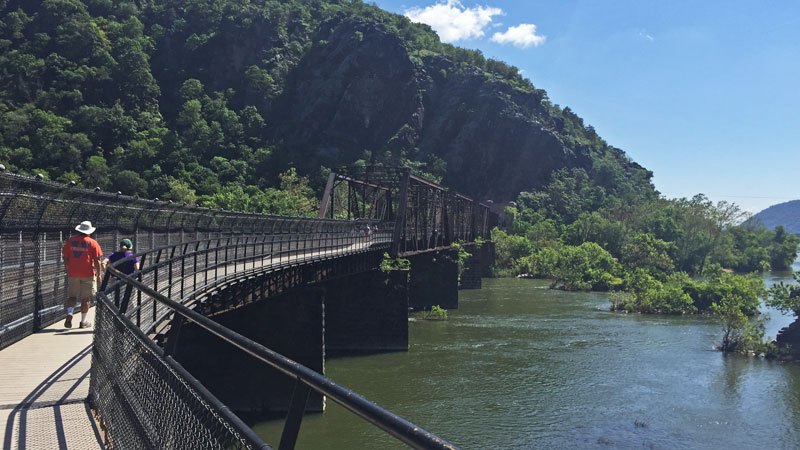
Dramatic moments in our nation’s history reveal themselves as you walk through Harpers Ferry National Historical Park, passing the site of Civil War battles, John Brown’s Fort and Storer College, one of the nation’s first institutions of higher learning open to all Americans. The hike starts at the ATC Headquarters and features iconic views from the Jefferson Rock, Harper Cemetery and the confluence of the famed Shenandoah and Potomac Rivers as you wind through the heart of the historic town.
Harpers Ferry Two-State Hike Through History
- Route type: Partial loop or “Lollipop”
- Hike Difficulty Rating: Moderate
- Hike length: 2.8 miles
- Elevation change: 250’
- Treadway: Mostly paved, short sections with gravel and grass, planks and some steep steps.
- Hike start location: 799 Washington St., Harpers Ferry, WV 25425
- Distance and direction from town center: In town
- Parking: Short-term parking available in the lot on Storer College Place, behind the visitor center. Staff can direct you to nearby options.
- 0.0 – From the ATC HQ and Visitor Center, turn left out the front door and walk uphill alongside the building along Storer College Way. (If you are parked in the ATC lot, you will need to move your vehicle; $1/hour parking is available on Washington Street, other options are available that staff can direct you to.)
- Continue uphill 50 yards on the path alongside Storer College Place, noting the blue paint blazes on posts and trees along the way — these mark the official side trail to ATC from the Appalachian Trail. If the ATC Headquarters is hallowed ground for the Appalachian Trail, you are now entering hallowed ground for African American history in the U.S. To your left, the grassy plot was once home to the first black president of Storer College, one of the first institutions of higher learning in America open to all Americans — the school welcomed men and women of all races beginning in 1867. To your right is the church built for the college.
- At the top of the hill, turn left onto Fillmore Street and continue along this quiet and charming back street for 0.4 miles. You’ll pass lovely homes, each one distinct, and several historic buildings that provide keys to understanding Harpers Ferry’s turbulent history.
- As soon as you turn left onto Fillmore Street, you’ll see an upright interpretive panel explaining the major themes that make Harpers Ferry National Historical Park such significant location.
- Take a little detour along the red brick path between the stone pillars so you can learn more about Storer College and the lives of its students, as well as the Civil War action that took place all around you. The walkway also affords the first of many views of the surrounding mountains. Although the blue blazes continue on to the A.T., we won’t pick up the A.T. just yet; head back to Fillmore Street.
- Note the yellow brick Odd Fellows Lodge that is now ahead of you; the Odd Fellows were a fraternal organization formed before the Civil War, so named because at the time it was felt by these members that doing good was considered odd. Keep heading downhill with the ornate iron fence to your right. You will note a black and white state historic marker providing a brief overview of the Niagara Movement, with notable figures such as W.E.B. DuBois convening here to meet with the organization that would later become the NAACP.
- 0.4 – Pass the Brackett House (brick building on your right). Before the Civil War, this building was the home to an Armory superintendent’s clerk. The building was later named for Storer College’s first principal and president, Nathan C. Brackett (who would also live there for several years). From 1972-1976, the building served as the first Harpers Ferry home to ATC Headquarters.
- 0.45 – Pass the Lockwood House (brick building on your right at the crest of the hill). If the grass is dry, take a slight detour to read about this building’s history and take in a majestic view seen by few who visit Harpers Ferry. The 1848 structure was built as the home of the Armory superintendent’s clerk. During the Civil War, it served as a hospital that treated Union soldiers. At the end of the war, Freewill Baptist missionaries from Maine utilized the Lockwood House as a school for former slaves. From here, continue around the building into the cemetery, gaining one of the most majestic views available anywhere, rather than returning to Fillmore Street. Follow the wide path through the cemetery to the grave of the revolutionary war soldier and the stone steps mentioned below.
- 0.5 – Enter Harper Cemetery at the end of Fillmore Street and walk along a grassy lane for about 50 feet, gaining a magnificent view of the famous gap through the Blue Ridge Mountains and a panoramic view.
- Turn left downhill to follow the stone steps through the grassy hillside when you see the gravestone with a black wrought-iron fence around it (a recently discovered tombstone for a Revolutionary War soldier).
- 0.6 – At the bottom of the hill, follow the path as it skirts the grave of town founder Robert Harper enclosed by a low stone wall and descend a series of stone steps — a few narrow ones, and then some very wide ones.
- 0.65 – At the bottom of the wide steps, you will officially reach the Appalachian Trail. Turn left, heading downhill. The steps here and the rock work in the vicinity were hand-built by volunteers with the Appalachian Trail Conservancy in the early 1990s. Note the white paint blazes on posts marking the Appalachian Trail.
- In about 100 feet, Jefferson Rock will be on your right, providing a view that Thomas Jefferson famously stated was “worth a voyage across the Atlantic” to see. Note that Jefferson Rock is unstable; because of this, walking on, climbing, ascending, descending or traversing Jefferson Rock or its supporting base rock is prohibited.
- On the paved path to “lower town,” take in more breathtaking views as you pass the crumbling remains of a church on your left and the ornate St. Peters Catholic Church on your right. This church survived shelling from both the Union and the Confederate armies during the Civil War because the priest cannily decided to fly the Union Jack flag. Take your time in this stretch: it’s one of the most scenic and historic spots on the entire Appalachian Trail.
- 0.75 – Follow very steep steps carved into the rock, which were placed in the 1800s. There are handrails to steady you if these provide a challenge. At the bottom of the steps, don’t miss the interpretive wayside on your left entitled “A Journey of 1,000 Miles Begins with a Single Step,” weaving together the history of those very steps, Storer College and the Appalachian Trail. Adjacent buildings house exhibits on “Black Voices: African American History,” Storer College and the Niagara Movement.
- Cross High Street (the lower end of Washington Street where you started your trek) and continue into a meticulously preserved courtyard from the 1800s. On summer weekends, you may encounter Harpers Ferry NHP staff in period dress conducting a baking demonstration from the era.
- 0.8 – At Potomac Street, turn right. Follow the white blazes painted on old-fashioned lampposts, crossing the end of Shenandoah Street. Just a block up Shenandoah Street is the park’s information center, where you can talk to a National Park Service ranger, view fascinating exhibits and inquire about park entrance fees.
- Pass John Brown’s Fort, one of the most significant buildings in our nation’s history. Here a battle took place when John Brown attempted to start an uprising in an attempt to free the town’s slaves. Many consider this action to be the first step in moving the nation toward the Civil War.
- 0.9 – Reach The Point at the confluence of the Potomac and Shenandoah Rivers. Be sure to walk up to the iron railing to get the best possible view.
- Head up the brick walkway, passing a four-sided interpretive kiosk that provides a wealth of information about the history of Harpers Ferry, amenities offered by the town and the national historic and scenic trails that converge here. You’ll also pass an Appalachian Trail sign, noting the mileage to Georgia in one direction and Maine in the other. It provides yet another great photo op.
- Cross the pedestrian footbridge over the Potomac River and step from West Virginia into Maryland as soon as you are over the river. The footbridge was built to connect Harpers Ferry with Maryland and allows exploration of the historic 184.5-mile C&O Towpath on the far side. Elevated above the river, the footbridge offers beautiful views and you can get a closer look at the many river-loving birds. Atop the trestle above you will see an osprey nest made of twigs; look closely for a nesting pair. Peregrine falcons — the worlds swiftest birds — are often observed perched on the granite rockface of Maryland Heights or whipping about on the winds above the river. Take time to scour the rock ledges to find them, as they blend in well with the gray stone. Easier to spot are slower-moving great blue herons who fly in a straight path above the river. You are almost nearly guaranteed to see turkey vultures and black vultures circling the air currents formed by the gap. If you’re lucky, you might spot the white flash of a bald eagle’s head or tail.
- 1.1 – At the end of the footbridge, follow the spiral staircase down to the river level and, at the base, turn left upstream (leaving the A.T., which heads downstream) on the Chesapeake & Ohio Canal National Historical Park towpath, following it for ½ mile. Along the way, admire the rapids along the Potomac River on your left and the C&O Canal on your right. This route is also part of the Potomac Heritage National Scenic Trail.
- Pass Lock 33 on the C&O Canal, one of many that raised and lowered water levels so that barges pulled by mules along the towpath could bypass rapids in the river and transport goods between Washington, D.C. and the hinterlands.
- 1.2 – As you pass the tall, white-barked sycamore trees along the water’s edge, listen for the loud distinctive sound of Baltimore orioles. Look above for flashes of brilliant orange as they flit among the treetops.
- 1.3 – Pass a large scar on the mountainside on your right, the result of a landslide that occurred in May 2018 after prolonged rains.
- 1.5 – Turn around at the small footbridge across the canal, where you’ll see the sign pointing to Maryland Height. From here, retrace your steps back to John Brown’s Fort. On the return trip, see if you can spot a bald eagles nest across the river.
- 2.2 – Back at John Brown’s Fort, continue up Potomac Street, taking time to scope out the restored Harpers Ferry train station and a wide variety of restaurants, shops and numerous ice cream parlors.
- 2.3 – Take the stairs uphill and turn right, going uphill onto High Street. You can also turn left and head back downhill for a block to catch the shops you might have missed.
- Continue ½ mile uphill on High Street (which turns into Washington Street) back to the ATC Headquarters and visitor center.
- 2.8 – Return to ATC HQ. Before going inside, take a moment to catch your breath and sit a spell in the peaceful Tribute Garden on the side of the building. Inspirational and moving tributes and quotes carved into the bricks, stones and benches in the garden illustrate the power the A.T. has on hundreds of people’s lives.
- Snap a selfie of yourself in front of the ATC’s famous wooden sign on the front porch, a tradition for hikers passing through the area. Then go back inside the visitor center and share the highlights of your trip with a volunteer or staff member, who is always eager to hear how people have enjoyed their journeys along the A.T. Now that you’ve hiked the Trail in two states, you might just want to dedicate yourself to pursuing the Appalachian Trail 14 State Challenge, pledging to hike a piece of the A.T. in every state.
Get Involved
Potomac Appalachian Trail Club
The Potomac Appalachian Trail Club (PATC) has enhanced the mid-Atlantic outdoor experience since 1927, including 240 miles of the Appalachian Trail in Virginia, West Virginia, Maryland and Pennsylvania. The PATC maintains trails, shelters and cabins, and they make maps and guidebooks for outdoor adventurers. Learn more and become a member today at patc.net.
Harpers Ferry-Bolivar Trail & Town Alliance
The Harpers Ferry-Bolivar Trail & Town Alliance is dedicated to preserving and promoting the recreational opportunities found in Harpers Ferry and Bolivar, working to organize events and improve local resources for visitors and community members. Learn more at facebook.com/HarpersFerryATcommunity.
ATC Volunteer Program
The Appalachian Trail Conservancy is always looking for dedicated volunteers to help maintain the A.T. and assist in our visitor center and headquarters. Opportunities range from greeting visitors and providing information about local hikes to joining a Trail crew for week-long maintenance trips, gaining first-hand experience in what it takes to keep the A.T. open and enjoyable for millions each year. Learn more at appalachiantrail.org/volunteer.

